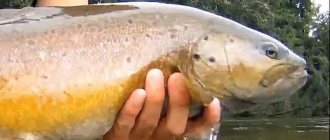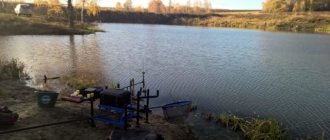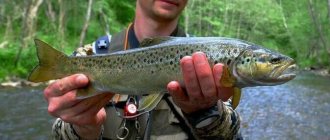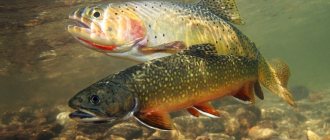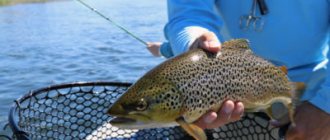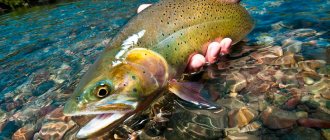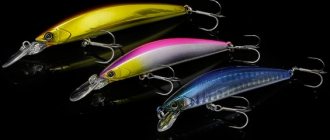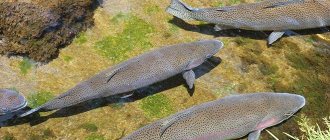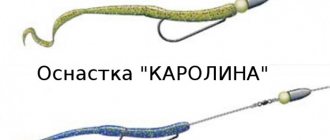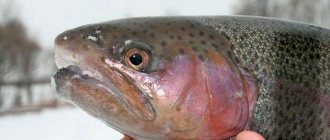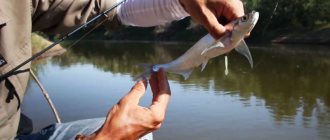Trout remains the most popular fish on the market year after year. And for good reason. People value it for its tasty, tender and fatty meat, which gives them a feeling of fullness for a long time. The fishing process itself also attracts people - trout fishing is one of the most enjoyable, full of unexpected turns. The feeling of excitement will give you an unforgettable experience, and a trophy specimen will delight the eye and memories for a long time.
One of the popular fishing methods for this specimen today is trout fishing with paste. This type of fishing is much more effective than fishing with natural bait. The bright, tempting taste and smell of trout paste will not leave any fish indifferent even in the most “well-fed” body of water. And availability, low price and big catch will not take long to arrive.
But, before you start looking for a suitable paste for trout, you should figure out which of the large variety will be the most successful option for fishing, also study the pros and cons of using it, and find out the behavior of the fish when fishing with paste.
What is fishing paste?
The pastes themselves for catching trout and other types of fish contain a considerable amount of protein and fish meal with minerals, as well as dyes and flavors, thanks to which this type of bait awakens the appetite of both predatory and peaceful fish.
It comes in small plastic jars, which are stored quite compactly and do not take up much space in your bag. The consistency of the paste resembles plasticine. Because of this property, it is quite convenient to give the bait different shapes in order to diversify your fishing and lift your spirits.
The most common flavors of trout paste, according to anglers:
- Cheesy.
- Garlic.
- Caviar.
- Fish.
These tastes are relevant because their pungent smell attracts hungry fish. For example, some fishermen noted that brown trout readily bite on red caviar. But due to the high price of such an exquisite bait, fishing enthusiasts use a budget alternative - fish paste with the aroma of caviar. Cheese paste is also good, especially for trout fishing. It is in no way inferior to its expensive analogue, but it does not hit the pocket so hard, and makes the bite much more intense.
The fish swims towards temptation without fear, completely forgetting that such food does not exist in its native reservoir. And the fisherman is happy, waiting for the next bite from the long-awaited predator.
Also, depending on the type of fishing, you can choose a paste of different consistency or density. There is sinking paste, and there is floating paste. It’s quite simple to make, just by sticking any type of paste around a foam ball. After such simple manipulations, you can safely cast the fishing rod.
Bombard
The modernized bombard float, equipped with a weight, helps to use long casts when fishing with a float rod. The technique of fishing with such equipment differs from classical fishing. After casting, a spinning retrieve is used: uniform with pauses (stop and go) or using animation (light twitching). Improving the gear adds the number of possible predator attacks. Floating paste is used for the nozzle.
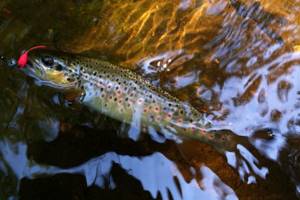
From the above information it is clear that paste for trout fishing is available in two types: sinking and floating. This division appeared specifically to improve the results of fishing with different types of gear.
Description of paste types:
- The sinking type of paste has a high specific gravity. It lands on the bottom with greater speed after casting. A similar paste consistency is used in feeder fishing. Can be used as a bait for fast jigging;
- floating paste floats in layers of water for quite a long time, in fact, it rarely reaches the bottom. Used for fishing for an active predator that feeds in the water column and notices any movement and food appearing on the surface.
Any type of paste uses the same ingredients that attract fish and activate them to bite. List of main components of trout paste:
- protein-rich mass;
- flavorings (garlic, cheese, fish, caviar);
- bite activators.
Such fishing is relevant when the specified individual is far away and it is not possible to throw a spinner with a spinning rod. In this case, a bombard is used to deliver the bait, which has an external resemblance to a float. This device has a spiral-shaped body mounted on an antenna with a hole for fishing line.
There is cargo inside. It can be located at the bottom, on the sides, distributed along the entire length, be in the center of gravity and extended at the bottom. For a good cast, use a fairly long rod (3.0-5.0 m). The fishing line is suitable for both regular and braided lines. Leash length – 1.5 m (with fishing line – 0.2 mm).
In this case, natural and artificial baits are used. It depends on the individual approach. The bombard makes it possible to cast light baits over long distances using a spinning rod. Further, the principle of operation resembles wiring with a “rotator”. Fishing for trout with a bombard is one of the favorite methods of avid fishermen. Because this method is quite effective.
Types and benefits of pastes.

There are quite a large number of paste manufacturers on the market. Each fisherman selects the most versatile bait for trout fishing. The main advantage of paste over other baits is its high performance.
Sinking paste is used for fishing at depth, in holes and pools, under snags and other objects. This type of bait quickly sinks to the bottom, avoiding any obstacles. The peculiarities in the behavior of fish at different times of the year should also be taken into account. At one moment the trout lives on the surface of the reservoir, and at some point it sinks and hides at the bottom.
Floating paste is suitable for shallow ponds containing a large amount of algae, branches, stones and other obstacles. Most often, brown trout react to bait floating on the surface, as it reminds it of a fallen midge or small fish.
The secret of catchy pasta
Any trout paste is made from a concentrated protein mixture with the addition of a strong flavor. Experienced fishermen consider the following smells to be the most attractive:
- garlic;
- cheese;
- fish;
- caviar
The bait can be produced in both sinking and floating versions. Most often, anglers prefer floating paste, since trout like to stay in the upper and middle layers of water. If the fish is hiding at depth, then in this case a sinking bait is used. However, it is not necessary to buy two types of pasta. The ingenuity of our fishermen is able to transform the bait to suit specific fishing conditions. For example, if you put a foam ball on a hook with a sinking bait, the equipment will rise above the bottom surface. To make a floating bait sink, just add the smallest lead pellet. Store-bought baits come in different colors; manufacturers try to provoke the fish by adding sparkles. Colors such as yellow, carrot, and pink have become popular with buyers.
How to put pasta on a hook.
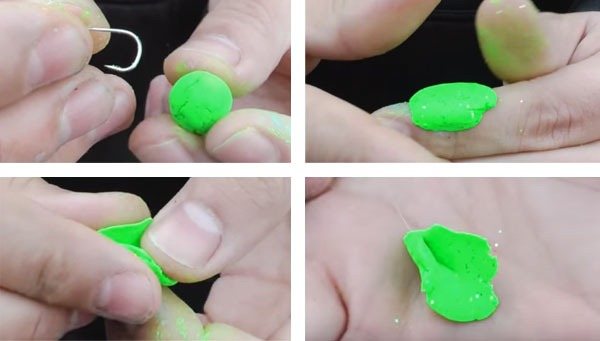
Using trout paste greatly simplifies the fishing process. Because you don’t have to spend a long time putting it on a hook, like with a worm or bloodworm. There are even special devices that make the process of “sculpting” paste even easier. The main rule is that there should be a distance of approximately 8-13 centimeters between the weight and the inserted paste.
To properly place bait on a hook, you should:
- Separate a medium-sized piece of paste from the jar from the total mass. If the paste is hard, you should warm it up in your hands first. Roll it into a ball or any other shape. Most often it is a ball, an elongated ball and a cone shape.
- Next, you need to place it on the fishing hook so that the tip of the hook disappears. Otherwise, when a fish bites, it may prick itself over the edge, get scared and swim away. Or, on a sunny day, the metal will glare and also scare the fish away from the bait.
- Then you need to adjust the shape of the paste and check whether this type of bait is suitable for the selected reservoir.
How to catch trout with a bombard.
Catching brown trout with a bombard begins with the choice of a float, which in the future will correspond to the flight range of the tackle and the horizon of the bait.
When using bait of natural origin, the leash is taken with a length of 30-7 cm, and spinning, artificial baits require the use of a leash of a meter or more in length. After determining the location, bait, trajectory and type of fishing, you should proceed directly to fishing.
Helpful information! On sunny days when fishing, it is recommended to take sunglasses that will reflect light, glare and ripples, which will help you accurately recognize the moment a fish bites.
After submitting the bait to the fishing area, you should wait for it to land in the required water layer. In the absence of bites, the fisherman changes the fishing style, making jerks longer and shorter. If there are noticeable disruptions in the movement of the bait, then you need to hook the fish by sharply pulling the rod towards you.
The caught trophy is stored in a landing net, since without water the fish quickly dies and can deteriorate or dry out. Especially when it comes to trout, since it is a fairly delicate fish.
To reinforce the words in practice, below is a video of trout fishing with a bombard. The activity is quite exciting and interesting. Once they try fishing, people enjoy it so much that they even take part in sports competitions to catch trophy trout and more.
Types of equipment for trout fishing with paste.
In the modern market, every fisherman can choose a fishing rod for himself. Fishing rods of both cheap and expensive price segments, in any case, will help the fisherman catch a catch. It's just a matter of the quality and durability of the materials from which the rod is made. Despite this, you still need to have an understanding of what equipment is suitable for which type of fish. So a little knowledge and experience in fishing is always good!
For each type of fish, the equipment of the rod is different. Just like fishing for trout with paste, certain equipment is required.
Spinning.
For trout fishing with a spinning rod, you should assemble the lightest, but nevertheless durable fishing rod. Moreover, fishing on the lake and in the river has its own nuances in terms of equipment.
The spinning rod, preferably ultralight, should reach a length of about 2.6 meters. For fishing on the lake, where long-distance casting of bait is required, the rod should be about 2.8-3.3 meters long. Most often, medium or light class models are suitable.
Feeder.
Equipment for trout fishing on a feeder can sometimes hit your pocket hard, as it is considered quite expensive. This type of fishing is relevant closer to autumn, when trout are no longer so active, but are still storing fat for the winter. Also, in addition to paste, flies, streamers and wobblers are used for feeder fishing.
Float rod.
Fishing with a float rod is the easiest option for beginners and advanced fishermen. Since this option is inexpensive and easy to equip, its popularity is justified. But to catch fish with such a fishing rod, you need to have a certain skill and understanding of the nature and behavior of fish.
To equip such a fishing rod, you will need:
- Any light rod;
- Inertia-free reel with friction clutch;
- Fishing line;
- Float, sinker, hooks for trout of different sizes.
A fishing rod about 4 meters long, with a sharp upper tier, shows itself best in action. These parameters allow you to move as compactly as possible to different places in the reservoir, and make accurate casts, despite the large amount of vegetation in the water.
For a float rod, it is better to use trout paste of the “floating” type. But, depending on the condition of the fish in the pond and the time of year, it is worth having both floating and sinking types of paste with you.
Bottom rod.
This type of gear is popular among experienced fishermen. Because it allows you to throw bait a long distance from the shore, into deep holes where large, or as they are also called, trophy trout specimens are found. Modern types of bottom fishing rods are equipped with a feeder. It is better to use nylon fishing line, and sinking type paste.
Bombard for trout.
This unusual type of tackle is not very popular for fishing; we have already talked about trout fishing with a bombard in detail. But, if we are talking about trout fishing, then a bombard is an irreplaceable thing. The bombard weight should be lead or brass. This will ensure maximum bait casting distance. The bombard itself should be as transparent as possible and made of plastic so that brown trout cannot notice sbirulino in the water.
The fishing technique with this unusual equipment is also different from others. After the bait has sunk to the bottom, you should retrieval quite slowly. You also need to take short pauses so as not to scare the wary trout.
Float rod
Catching trout with a fishing rod and float does not require a professional approach. All you need to do is collect the following gear:
- blank 3.5 – 4.5 mm long (a telescopic rod can be used);
- inertia-free reel with a spool size of 3000 - 4000 according to the Shimanov classification;
- main scaffold with a diameter of 0.18 - 0.22 mm, a length of 70 - 100 m;
- fluorocarbon leader with a diameter of 0.15 - 0.20 mm, a length of 0.25 - 0.50 m;
- single hooks No. 10 – 14;
- Medium sized sliding float.
Floating paste is used as bait, which raises the hook from the bottom, which brings more bites.
Fishing for trout with a float does not differ much in terms of installation from most methods of forming equipment for catching peaceful fish. The assembly algorithm consists of selecting a fishing line on which a float balanced by weights, a leash and a hook are attached. The auxiliary accessories for the trout float mounting kit will require swivels, silicone stoppers and quick-release carabiners.
If possible, equipment should have as few elements and connecting nodes as possible.
Coil
In Bolognese and match fishing rods, the equipment includes reels. Inertialess ones are more popular for assembling gear. They are easier to manipulate when casting and landing fish, they are unpretentious in maintenance and hold a large amount of fishing line, ensuring even the longest casts without worrying about the supply necessary for these purposes. For both matcha and lapdogs, small-sized mechanisms of 1500-2500 units are selected with only a friction clutch, without unnecessary functions.
For the sake of objectivity, it is worth noting that there is an opinion that claims that it is more comfortable to catch trout with a fishing rod equipped with an inertia rod. There is some truth in this, since these types of reels are much lighter than the meat grinders familiar to most anglers. But perfect mastery of the casting technique and the lack of a thin clutch mechanism are serious obstacles to their widespread use in trout fishing by ordinary, and even more so, novice fishermen.
Since hunting is carried out at medium and short distances, catching trout with a float rod is ensured by using monofilament fishing line as the main cord. In addition, the monofilament is transparent and does not arouse suspicion in the fish, and its high stretch coefficient quite successfully helps to cope with the sometimes fierce resistance of the trophy that takes the bait.
We suggest you read: How to choose trout baits and the top 10 best options
Hooks
When selecting a hook for a float mount, they are guided by the type of bait used in fishing. Often the range of an effective and practical piece of equipment falls within the range of 6-10 accessory numbers. When planning to catch large specimens of predators, the use of larger hooks of numbers 3-5 is justified.
If fluid baits, trout pastes or dough are used as bait, then hooks with springs are installed in the rigs, which reliably and for a long time hold the bait in the water and during casting. Otherwise, the hooks should have natural color tones, gray or dark blue, and, of course, a sharp point.
Often, at the beginning of fishing, the fishing technique with two hooks is justified. The method allows you to much faster determine the horizon of active fish and, after reconnaissance, switch to the classic type of equipment with one hook. An additional leash can be made longer or shorter than the main one, as well as equipped with different types of bait and thus find the most promising fishing option, increasing the chances of ultimate success.
Floats
The practice of trout fishing shows that drop-shaped, oval or spherical floats are the most effective for fishing. The lower part of the alarm, submerged in water, is painted in non-garish natural tones, but the float antenna, on the contrary, should clearly stand out with its colors on the surface of the reservoir. Fishing on paid platforms has more comfortable conditions, which is why the mass of floats rarely exceeds 10 grams.
Basically, fishing is carried out using signaling devices in the range of 1.5-4 grams. For matcha, sliding types of floats are used; for bologna and swing, it is more practical to use floats with a blind fastening method. In fishing stores you can find floats specialized for trout fishing, the designs of which, with factory settings, take into account the nuances and characteristics of trout biting.
A special feature of fishing for the predator we are considering is the constant animation of the bait. The fish rarely reacts to a stationary bait.
Often, the natural movements of a live bait or the waves of a reservoir are sufficient for animation, but in calm conditions the angler has to constantly twitch the rig, attracting active trout to the inert bait. During the current, the bait is floated along the stream, holding the rod in promising places. Active fish can take the bait during its dive, immediately when casting. The predator's bite is sharp. The predator does not try the bait, but tries to immediately swallow the object it likes.
When bitten, the float sinks to the bottom or quickly moves to the side. The fisherman must respond to such signals by immediately hooking and forcing the landing of aggressively resisting fish. Near the shore, the trophy is taken into a landing net with a long handle, since the fish brought to the shore increases the pressure and often with the last jerk breaks off the thin leashes, depriving the fisherman of well-deserved success.
DIY trout fishing paste.
Trout paste, like paste for any other type of fish, is the result of long efforts from different manufacturers. Which achieved the ideal consistency and aroma of the paste. So making exactly the same product at home will be quite problematic. But, nevertheless, recipes for homemade pasta still exist. Homemade trout paste can have different compositions. Most often it is a specially kneaded dough to which flavorings or natural products are added.
Here are a few recipes if you don’t have time to find the right pasta, or it’s simply out of stock.
- Two chicken eggs are mixed with milk. The mixture is fried in a frying pan like an omelette. The only difference is that the omelette must be constantly stirred so that excess moisture evaporates.
Trout feed, bran or ground daphnia are usually added to the prepared omelet. 1-2 glasses will be quite enough, depending on how long you plan to fish.
The most aromatic cheese is used as a flavoring component. It needs to be finely grated, added to the total mass, and mixed thoroughly. The more cheese there is, the stronger its aroma will be, therefore, the greater the chance that the fish will smell the bait and get hooked.
Also a good alternative or addition to cheese would be chopped sprat, herring, or any other type of aromatic fish. Also, for those who like to play around with expensive baits, you can add natural red caviar or finely chopped squid to the mixture.
The final ingredient in this mixture is mashed corn. It will also add a little flavor and allow you to stir the paste without difficulty.
The consistency of such a paste should be like plasticine, slightly stick to your hands, fairly pliable, and hold its shape.
- To prepare the second pasta recipe you will need flour, eggs, water or milk if desired. Knead regular dough. In terms of consistency, it should not stick to your hands, hold its shape well, and not spread.
When kneading the dough, you can add any very aromatic ingredients to it. For example, finely grated cheese, fish, squid. The more additives there are in the dough, the stronger the smell of the bait, and the higher the chance that the trout will smell the bait and swim to the fishing spot.
Popular methods of trout fishing.
- Fishing with a float rod.
The most common and budget option for catching all types of fish. Does not require special skills or costs.
- Spinning fishing.
When using a spinner, the chance of getting a catch increases greatly. The tackle is thrown in the direction against the flow of the reservoir. The most favorable time of year for spinning fishing is summer.
- Fly fishing.
This fishing option is very popular among those who like to hunt for valuable trout. It is effective regardless of the time of year. The versatility of the method lies in the correct selection of fishing line, hook and bait.
Fishing with trout paste.
All anglers who are just beginning to understand the types of bait have a question about how to use paste to catch trout.
Trout, in itself, like a predator, feeds on fry, midges that have fallen into the water, and mosquitoes. As a fish, it is extremely aggressive and tied to its habitat. Most often, this is a deep hole, to which the brown trout prefers not to allow unnecessary guests to approach, and will defend its territory to the end. Because she chooses her parking spot carefully. He makes sure there is enough food and comfortable living conditions.
At times of the year when the fish are carefully preparing for winter, or, on the contrary, leaving it, the bite increases significantly. A hungry fish loses its vigilance and does not particularly care about its safety in search of food. And right there, a fisherman is already waiting for her, with a tasty and aromatic pasta on a hook. The temptation for trout is too great to miss such a delicacy.
Since we are talking about trout fishing at different times of the year, it is worth taking into account the characteristics of pressure, temperature and floods, which are different in different periods. For example, due to high pressure, fish do not appear on the surface of the water, so you need to look for them at depth, in silty holes and pools.
In winter.
In the harsh and cold seasons, you will have to modify the usual style of equipment. It is recommended to replace the standard fishing line with a stronger one made of fluorocarbon. To catch large trout, the thickness of the fishing line should be about 0.20-30mm. Due to the transparency of this type of fishing line, it will be very difficult for fish to notice it in clear, icy water.
Part of winter fishing success is knowing how fish behave during this harsh time of year. In winter, fish are extremely picky in their choice of food, which is why it is extremely difficult to please them. Today she pecks at the corn, but tomorrow she won’t even look in its direction.
Therefore, when fishing with pasta, the fisherman is recommended to take several pasta options with him. If the fish doesn't like one taste, it will definitely taste another. Experienced fishermen noted the fact that in winter brown trout bite well on shrimp paste.
In winter, like all other living beings, trout experience a shortage of food in their usual environment. Therefore, it fights more actively and aggressively for the bait, and easily gets hooked. A novice angler just needs to play with the bait a little and catch the attention of the fish.
In the spring.
Spring is the time when all nature comes to life. With it, the fish also begins to become active. After a long winter, she literally begins to feel hungry. At this time of year, the most catchy places are considered to be riffles and areas of the reservoir where the depth is quite shallow. Because in these areas the water has already thawed and warmed up, and food has appeared in it.
With each month of spring, the bite becomes stronger and stronger, so this is a good time of year for catching both trophy specimens and small trout.
Fishing from the shores of the reservoir becomes relevant from early to mid-April. Fishermen noted that pasta with salmon and shrimp flavors is very popular at this time.
But spring fishing also has its downsides. A person will have to fight for the right to feed the fish, since there is plenty of natural food in the reservoir, and the predator bites sluggishly. But the fishermen do not despair, and over time they have become accustomed to this behavior of the fish.
You can attract her attention with bright, colorful baits. There is a multi-color paste option for this purpose. But you shouldn’t play with bait in the spring. On the contrary, this will only scare the fish away from the fishing spot.
In summer.
For those who expect an active fish bite in the summer, there is extremely unpleasant news. During the hot season, trout are almost inactive. But the fisherman, on the contrary, will have to show remarkable patience. It is very rare to catch trophies in the summer, and small specimens are also reluctant to bite.
Nevertheless, if fishing takes place in the summer, then in such cases fish should be looked for in areas of the reservoir shaded by trees. Fishing at great depths, far from the shore, is also relevant. There the fish gather in schools and cool down. There is still a chance to stumble upon trout in those places where the water has a fast flow, that is, it cools the most and is saturated with oxygen.
The best time of day for fishing in summer is early in the morning. When the fish has not yet recovered from the cool of the night, and is looking for food in shallow, coastal areas of the reservoir.
Also on calm, windless days, trout are especially shy. Therefore, you need to cast the bait to depth as carefully as possible so as not to create unnecessary waves and fluctuations in the water.
